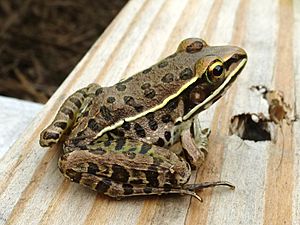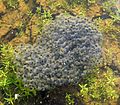Southern leopard frog facts for kids
Quick facts for kids Southern leopard frog |
|
|---|---|
 |
|
| Conservation status | |
| Scientific classification | |
| Genus: |
Lithobates
|
| Species: |
sphenocephalus
|
| Synonyms | |
|
|
The southern leopard frog (Lithobates sphenocephalus or Rana sphenocephala) is a type of true frog. It lives naturally in eastern North America. Its home range stretches from Kansas to New York and all the way down to Florida. This frog has also been introduced to other areas by people.
Contents
What Does the Southern Leopard Frog Look Like?
This frog can grow up to 13 centimeters (about 5 inches) long. It is usually green or brown. It has a yellowish line or ridge along each side of its back. You can see rounded dark spots on its back and sides. There is also a light spot on each eardrum, which is behind its eye.
Male frogs have bigger front legs than females. When a male frog calls, its vocal sacs look like round balloons. Its call sounds like a "ratchetlike trill" or a "chuckling croak." Some people say it sounds like a "squeaky balloon."
Tadpoles and Eggs
The baby frog, called a larva or tadpole, has a mottled (spotty) pattern. Its eyes are on top of its head. A tadpole can grow to about 7.6 centimeters (3 inches) long before it changes into a frog.
A female frog lays a mass of eggs that can be "baseball-sized" when it's almost time for them to hatch. This egg mass can hold up to 1500 eggs!
Where Do Southern Leopard Frogs Live?
This frog lives in many kinds of shallow freshwater places. Sometimes, it can even be found in slightly salty water. It usually stays close to water. However, it can also spend a lot of time on dry land. During warmer months, it often moves away from the water.
Daily Life and Habits
Southern leopard frogs are mostly active at night. This is called being nocturnal. But they can also be active during the day, especially when it rains.
In colder northern areas, these frogs become inactive during winter. This is called being dormant. They stay in water bodies that have enough oxygen and do not freeze.
What Do Southern Leopard Frogs Eat?
Southern leopard frogs mostly eat insects. They also enjoy crayfish and other small creatures without backbones, called invertebrates. During the summer, they often look for food in higher, drier areas away from the water.
Reproduction and Life Cycle
Southern leopard frogs breed in winter and spring. Sometimes, they also breed in the fall. Heavy rain often makes them start breeding. The female attaches her egg mass to plants in the water.
When the weather is cooler, many frogs might lay their eggs together in one spot. When it's warmer, they might lay eggs individually. The eggs hatch in about 4 days to almost two weeks. The tadpoles then take about 50 to 75 days to grow into adult frogs.
Where Are Southern Leopard Frogs Found?
This frog is common across eastern North America, especially in the southeast. It is the most common frog in Florida and in several other regions.
It has also been introduced to other places. For example, it is now found in The Bahamas. It has also been found in two places in California. Southern leopard frogs are thought to have arrived in the Prado Flood Control Basin in California around 1929 or 1930. They came with other water animals sent to a gun club. Now, they are common in parts of that area. A second group of these frogs was found in California in 2016, near the San Joaquin River.
Types of Southern Leopard Frogs
There are two main types, or subspecies, of the southern leopard frog:
- L. s. sphenocephala – This is known as the Florida leopard frog.
- L. s. utricularia – This is the southern leopard frog.
Gallery
- AmphibiaWeb, available at http://amphibiaweb.org/
See also
 In Spanish: Lithobates sphenocephalus para niños
In Spanish: Lithobates sphenocephalus para niños





